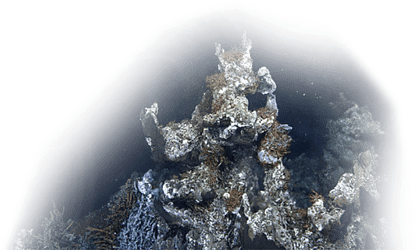Ocean Networks Canada’s video archive and annotation tool, SeaTube, is helping drive a collaborative global understanding of subsea maritime cultural heritage, including rare glimpses at underwater archaeological sites from the Second World War.
In partnership with the National Oceanic and Atmospheric Administration (NOAA) and Ocean Exploration Trust (OET), 73 hours of visual surveys of historic shipwrecks from the Battle of Midway in the Central Pacific Ocean are now available on SeaTube. The platform’s built-in features enables the public to see the deep sea sites, and for the international scientific community to collaboratively annotate these important historical records.
As we honour armed forces members on Remembrance Day, Ocean Networks Canada (ONC) is highlighting the availability of these and other visual surveys of deep ocean heritage sites on SeaTube as a contribution to the evolving discipline of maritime archaeology.
Surveying fallen ships from the Battle of Midway
During fall 2023, OET in partnership with NOAA Ocean Exploration and funded through NOAA’s Ocean Exploration Cooperative Institute completed the remotely-operated-vehicle based surveys of three Battle of Midway marine archaeology sites at depths below 5,000 metres.
Spanning three dives now viewable on SeaTube complete with annotations, these detailed archaeological assessments are the first visual survey of IJN Akagi 赤城, the first detailed views of USS Yorktown since it was located 25 years ago, and a complete visual survey of IJN Kaga 加賀.
SeaTube supports unlimited, geographically separated groups of users who can apply annotations to a video stream either during or following an at-sea expedition. In the case of the Midway surveys, international archaeologists from the United States, Japan and Canada were invited by NOAA and OET to review the high-resolution video imagery through ONC’s platform and submit explanatory notes.
“Making video data more accessible, usable, and valuable is a primary objective for NOAA Ocean Exploration archaeology. SeaTube has allowed many contributors to record observations on USS Yorktown, Akagi, and Kaga from wide perspectives, disciplines, and expertise,” said Phil Hartmeyer, marine archaeologist at NOAA Ocean Exploration. “Through SeaTube's data and annotation analysis tools, we have made strides in how the maritime heritage community uses our video data and are on the path to making these data more impactful.”
Since 2016, ONC has been partnering with NOAA to integrate SeaTube as part of all exploration cruises and plans to submit future maritime heritage-focused video data for similar, collaborative data interpretation experiences.
Currently, additional video surveys completed by NOAA that are available on SeaTube include, exploration of a US Navy S-Class submarine as well as sonar anomalies, believed to possibly be B-29 bombers downed in the Pacific Ocean that were flying long-range missions to Japan.
“With the ongoing exploration of marine archaeology sites, SeaTube’s value is in facilitating an invited global crowdsourcing of knowledge from a broad range of experts,” said Gord Rees, ONC’s associate director, applied science solutions. “The structured annotation capacity and mechanisms for review creates opportunities for improving our understanding of the historical record.”
SeaTube is an integrated component of ONC’s data management portal Oceans 3.0 and allows users to easily download clips or create playlists for education and public outreach.
“Time capsules” in the deep ocean
University of Victoria professor of military history, David Zimmerman explains that the Battle of Midway was a critical juncture at sea during the Second World War as over 3,000 Japanese and 362 Americans died.
“Midway was the turning point of the war in the Pacific; the core of the Imperial Japanese Navy was destroyed and could not be replaced. It’s one of the most decisive naval battles in history,” said Zimmerman. “After Midway, the Japanese would be gradually pushed back to their home islands.”
Historians can now further study the surveys of the wreckage to observe how these “time capsules” have preserved some of the weapons and technology that was aboard; USS Yorktown was one of the first ships to be equipped with radar.
“The Yorktown was hit by two torpedoes from Japanese aircraft, and later by additional torpedoes from a Japanese submarine. It’s fascinating to be able to see what conditions those ships are in now and the damage inflicted upon them to sink them,” said Zimmerman.
As one of Canada’s Major Research Facilities, ONC is committed to enhancing SeaTube and related ocean observing products to meet the needs of science, society and industry. We continue to explore future prospects for hosting additional marine archaeology content and making it available to interested groups.
“This data was collected by Ocean Exploration Trust’s (OET) E/V Nautilus during the Ala ʻAumoana Kai Uli expedition to the Papahānaumokuākea Marine National Monument (NA154). The expedition was funded by NOAA Ocean Exploration via the Ocean Exploration Cooperative Institute, and executed under Research Permit PMNM-2023-003 approved by the State of Hawaiʻi, Office of Hawaiian Affairs, NOAA, and US Fish and Wildlife Service. The Battle of Midway exploration dives were made possible by the expertise, support, and collaboration of many partners, including the captain and crew of E/V Nautilus, Ocean Exploration Trust, Nautilus Corps of Exploration, NOAA Ocean Exploration, NOAA Office of Marine National Sanctuaries, US Naval History and Heritage Command, Defense POW/MIA Accounting Agency, SEARCH Inc., Teikyo University, Tokai University, Tokyo University of Marine Science and Technology, Air/Sea Heritage Foundation, International Midway Memorial Foundation, and Bureau of Ocean Energy Management. The expedition benefited from the great wealth of knowledge that was collected during previous explorations of the Battle of Midway sites, including those by Dr. Robert Ballard, Navy, National Geographic, Nauticos, and Vulcan LLC, among others. Over 3,400 sailors lost their lives during the historic Battle of Midway on June 4-7, 1942; we honour their sacrifice and stories.” Read more about the Battle of Midway survey expedition.
